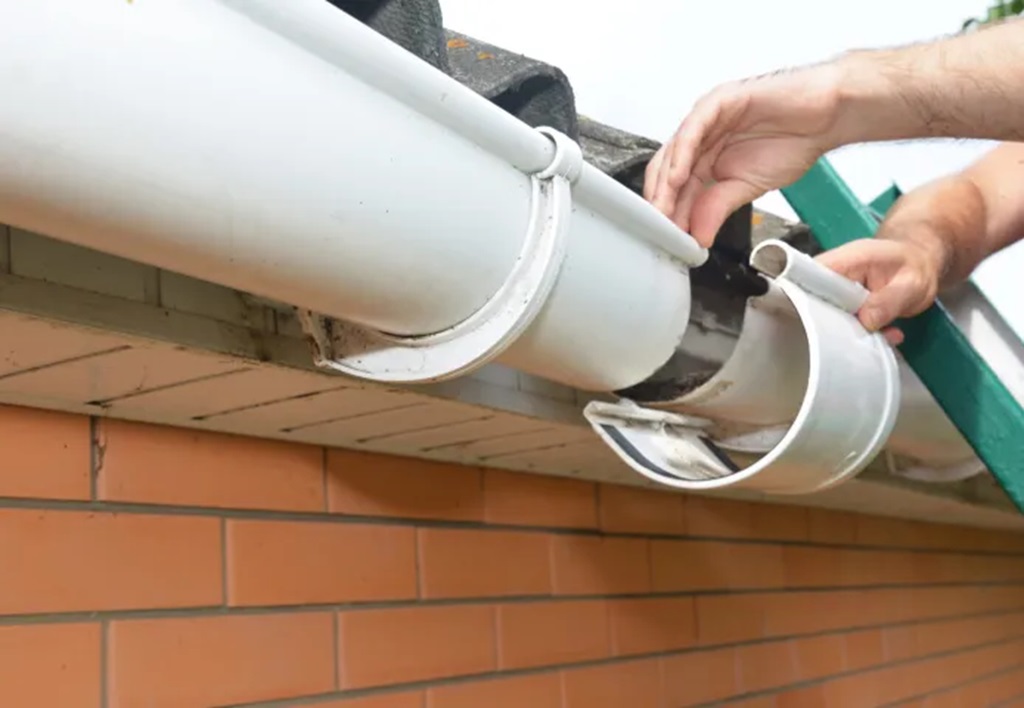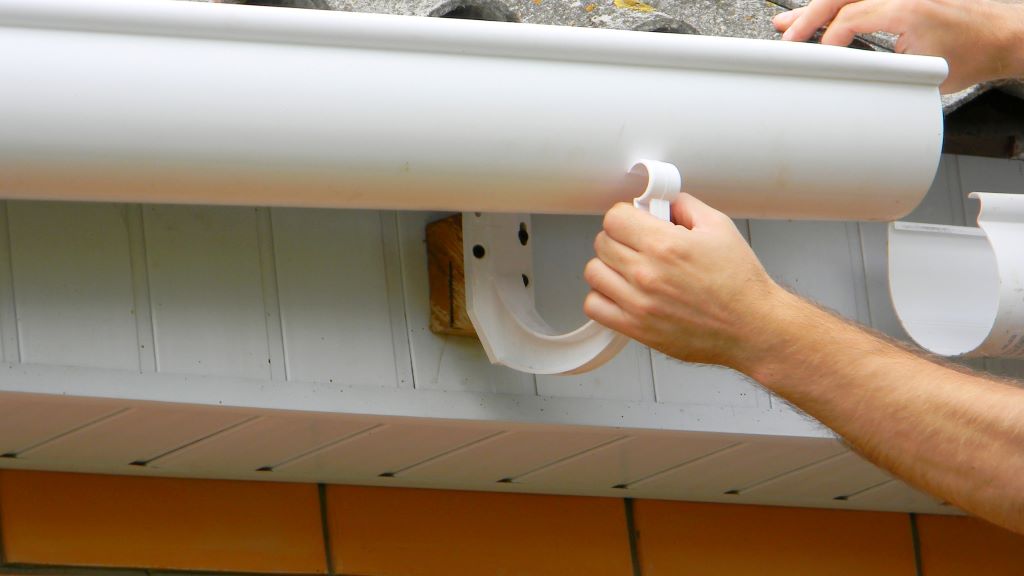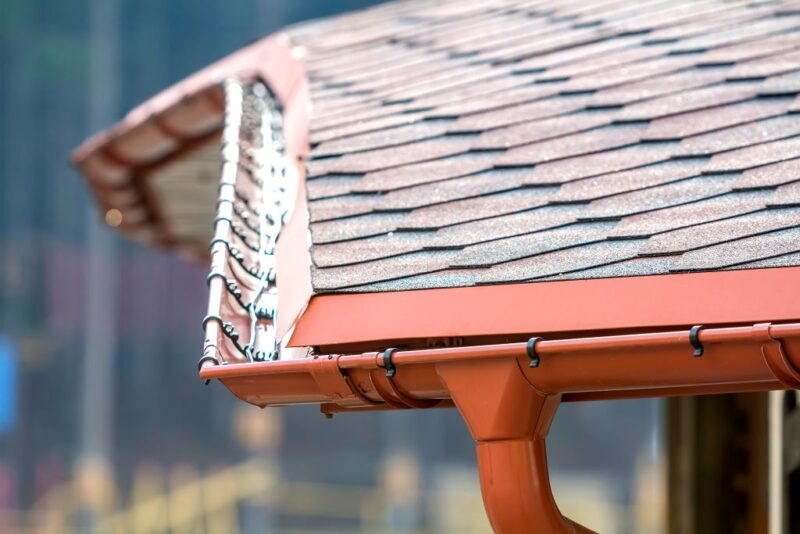A properly sloped gutter is crucial for directing water away from your home. If your gutters don’t have the right pitch, you may experience issues like water overflow, moisture damage, foundation erosion, flooded basements, and more. Luckily, most homeowners find fixing gutter slopes a relatively straightforward DIY project.
What is a Gutter Slope?

Gutter slope refers to the angled pitch of your gutters that allows gravity to pull water downhill. The slope causes water to flow towards the downspouts instead of pooling in the gutters.
A proper gutter slope is usually a drop of 1 inch for every 20 feet of gutter. That equals a 0.5% slope. If your gutters are 40 feet long, they should drop 2 inches from the high point to the low end where the downspout connects.
Some key things to know about the gutter slope:
- The slope is measured by rise overrun. For example, a 1-inch drop over 20 feet is a 1:240 ratio.
- Gutters should slope 1/4 inch for every 10 feet of gutter.
- The slope should be uniform without any flat spots or reverse slopes.
- Gutters need a minimum of 1/8 inch per foot of slope.
- The optimal slope is between 1/16 inch and 1/8 inch per foot.
- Downspouts should be placed at the low points where gutters direct water.
- Slope direction should move water away from your home.
Proper gutter slope is crucial for effective water diversion. When gutters are too flat, water pools up and doesn’t drain properly. Steeper slopes can sometimes move water too quickly before it’s discharged from downspouts.
Signs You Need to Fix Gutter Slope
Many homeowners don’t realize their gutters have slope issues until problems arise. Here are some clear signs that your gutter pitch needs adjustment:
Overflowing gutters
If you notice water overflowing from your gutters and spilling down the fascia, lack of proper slope is likely the culprit. Without enough pitch, water accumulates faster than your downspouts can drain.
Standing water
Flat areas along your gutters allow water to collect and stand for prolonged periods. Mosquitoes and other pests can breed in these stagnant zones.
Leaks along shingles
With flat or back-sloped areas, water may creep up and under shingles rather than down towards the eaves. This can cause interior leaks and water damage.
Rotting fascia boards
Poor drainage often causes moisture damage and wood rot on fascia boards behind gutters. The constant exposure to water can deteriorate the structure and aesthetic of the overhang.
Eroding soil around the foundation
Improperly sloped gutters spill water near the base of your home’s foundation. This leads to erosion, sinking, cracks, moisture issues in basements, and damage to landscaping.
Mildew and peeling exterior paint
Areas of exterior walls near overflowing downspouts may have excessive moisture. This can cause mildew stains and premature peeling of exterior paint.
Structural foundation damage
Continuous heavy rainwater spilling around the base of your home can lead to foundation problems. Water causes the soil to expand and contract, which stresses and shifts the foundation.
If you notice any of these issues, inspect your gutters for flat areas or reverse slopes that disrupt proper drainage.
How to Measure Gutter Slope
Before determining solutions for improper gutter slope, you must thoroughly measure and assess the current pitch. Here are two easy methods to measure slope:
Use a level
A basic carpenter’s level is an easy tool for testing slope. Place the level across different sections of your gutters. Level gutters should show the bubble between the lines. If the bubble is off to one side, that indicates an angle. Note areas that seem too steep, flat, or angled in the wrong direction.
Measure drop over distance.
Physically measuring the inch drop over a set distance will give you the most precise sense of your current slope. Here are the steps:
- Measure along the entire length of your gutters and record the total linear footage from end to end.
- Starting at one far end, make a mark on the interior front lip of the gutter.
- Make another mark precisely 10 feet away from the first mark.
- Extend a string between the two marks across the length of the gutter interior.
- Use a ruler to measure the distance in inches between the string and gutter at the center point between your two marks.
- Divide the inch measurement by 10 to calculate the slope ratio.
For example, if the string is 1/2 inch away from the gutter, your slope is 1/2 inch per 10 feet or 1 inch per 20 feet. That equals a 0.5% slope.
Use this process in several spots to map out the complete slope profile. Make notes on sections that are too flat or steep.
How to Increase Gutter Slope
Once you thoroughly measure your current gutter slope, you can determine solutions to improve drainage. Here are some common ways to increase gutter pitch:
Add slope boards
Slope boards are angled wooden planks installed under one side of the gutter. They manually create the tilt needed to achieve a proper slope. This is easiest for shorter gutter spans.
Cut a long 1×3 or 1×4 inch wooden board to fit the interior length of the gutter. Prop one edge up on spacers to create the needed angle. Secure into place with gutter screws.
Use slope adapters
Plastic slope adapters attach underneath gutters to provide lift on one side. They snap together in segments to produce the required length. Adapters are convenient since they don’t require cutting lumber. However, too many connected pieces may sag in the middle over time.
Replace gutters
If large sections of your gutters are pitched incorrectly, replacement may be needed. When installing new gutters, use a level to adjust hangers until the desired slope is reached carefully.
Consider seamless steel or copper gutters. The single-piece construction often allows more accuracy when angling pitch.
Adjust gutter hangers
Most gutters are mounted using galvanized steel hangers screwed into the fascia board. Adjusting these hangers is the best way to alter the slope.
Remove gutter sections and detach the hangers. Measure and reposition each hanger using shims to get the proper angle. Rehang gutters section-by-section.
Re-slope the roof edge.
In extreme cases, the roof line itself may not have proper pitch. This makes correctly sloping gutters difficult. Reframing the roof edge is an intensive option but may be the only way to get adequate gutter drainage.
Consult a roofing contractor to discuss options for adjusting your roof line’s edge pitch.
Step-by-Step Guide to Adjust Gutter Slope
Here is a step-by-step walkthrough for adjusting your gutter slope by altering the hanger positions:
Materials Needed
- 4-foot level
- Tape measure
- Pliers
- Flat pry bar
- Aviation snips
- Shims
- Power drill
- Screwdriver bit
- Gutter screws
Steps
- Assess the current slope. Use the methods above to identify problem areas that need adjustment.
- Remove gutters. Take down sections where hangers will be repositioned. Remove hangers from the fascia.
- Detach downspouts. Unscrew downspouts so they can hang freely during the process.
- Map hanger positions. To achieve the proper slope, measure and mark precisely where each hanger should attach.
- Cut shims. Use aviation snips to fabricate shims to set each hanger at the needed angle.
- Reattach hangers. Screw hangers into the fascia at the marked positions. Place shims underneath to create the tilt.
- Rehang gutters. Mount each gutter section in the adjusted hangers. Use a level to double the slope.
- Reconnect downspouts. Attach downspouts in their original drain positions. Add elbows if needed.
- Test drainage. Run water into the gutters and look for proper flow without overflow. Make minor hanger adjustments if needed.
- Seal connections. Seal all gutter seams and downspout connections. Test again for leaks.
Adjusting gutter hangers gives you complete control over slope angles. Take your time measuring and testing fitting pieces to achieve optimal drainage. Don’t be afraid to tweak your shim height as needed.

Preventing Future Gutter Slope Problems
After successfully fixing your gutter slope issues, you can take further steps to prevent new problems down the road:
- Inspect gutters twice per year. Look for debris buildup, overflow indicators, and flat areas. Address any minor issues before they escalate.
- Consider leaf guards. Installing gutter guards or screens prevents debris buildup that can clog areas and lead to standing water.
- Extend downspouts. Position downspouts to discharge at least 5 feet from your home’s foundation. This fully drains water from the roof without pooling around the base.
- Add splash blocks. Install splash blocks or drain tiles under downspouts to control the water flow. This prevents erosion and foundation damage.
- Maintain a positive slope. When cleaning gutters, check that debris removal hasn’t created any flat spots. Refill any low areas with additional slope material if needed.
- The patch leaks quickly. Inspect for leaks during rainstorms. Repair any seams or holes where water is entering the gutter system.
- Realign sagging gutters. Look for gutters pulling away from fascia boards, which can create a reverse slope. Rehang gutters if needed.
- Consider gutter guards. Screen mesh gutter guards help minimize debris buildup that clogs drainage. It is beneficial for homes with overhanging trees.
- Update old gutters. If your gutters are severely rusted or deteriorated, replacement may be needed. Install new gutters with proper slope.
- Divert snow melts. Install heat cables along the roof edge to melt snow that can otherwise overload gutters and downspouts.
Proper gutter maintenance will help preserve the slope you establish during your repair project. But it’s also wise to periodically measure pitch to catch any issues early.
FAQs
How do I calculate the proper gutter slope?
General guidelines recommend a 2-inch drop for every 40 feet of gutter length. That equals a 1/4 inch slope for every 10 feet of gutter. The ideal slope is between 1/16 and 1/8 inch per foot of gutter.
What tools do I need to measure the gutter slope?
You can measure slope using a 4-foot level and physically measuring the inch drop over a set span. A string level makes it easy to track the hill across a long run. You’ll also need standard tools like tape, screwdriver, pliers, snips, shims, and drill.
Should gutters slope towards or away from the house?
The slope direction should move water away from your home or building. Typically, this means sloping gutters towards the outer edge of the roof eave. Downspouts are installed on that outer edge to drain water away.
How do I increase the slope on vinyl gutters?
For vinyl gutters, adjusting the hanger positions is the best method. Remove hangers, measure for proper slope, cut shims, and rehang gutters section-by-section using shims to achieve the pitch.
Can I add new shingles to create a gutter slope?
It’s not recommended to try altering the roof pitch by adding shims or layers of shingles. This throws off the roof slope and can cause leaks or other damage. Adjust the gutter hangers rather than tampering with shingles.
What slope is needed for copper gutters?
Copper gutters require a steeper slope since copper is stickier and more prone to debris buildup. Aim for a 1-inch drop per 16 feet of gutter length. That equals around 1/8 inch of slope per foot.
Conclusion
Fixing gutter slope is one of the best ways to optimize drainage and prevent joint home exterior damage due to water issues.
Carefully assessing your current slope, determining the remedies needed, and methodically adjusting hanger positions take time and precision. But the end reward is properly functioning gutters that move rainwater safely away from your home.
When searching for gutter installation companies, be patient during the process, and don’t be afraid to tweak shim angles as you test sections. Remember to make gutter inspection and cleaning a routine in the future – catching minor issues early ensures a proper slope for maximum drainage performance.
Your gutters are the first line of defense in controlling roof water runoff. Take the time to fix slope problems; you’ll protect your home from unnecessary damage for years.

